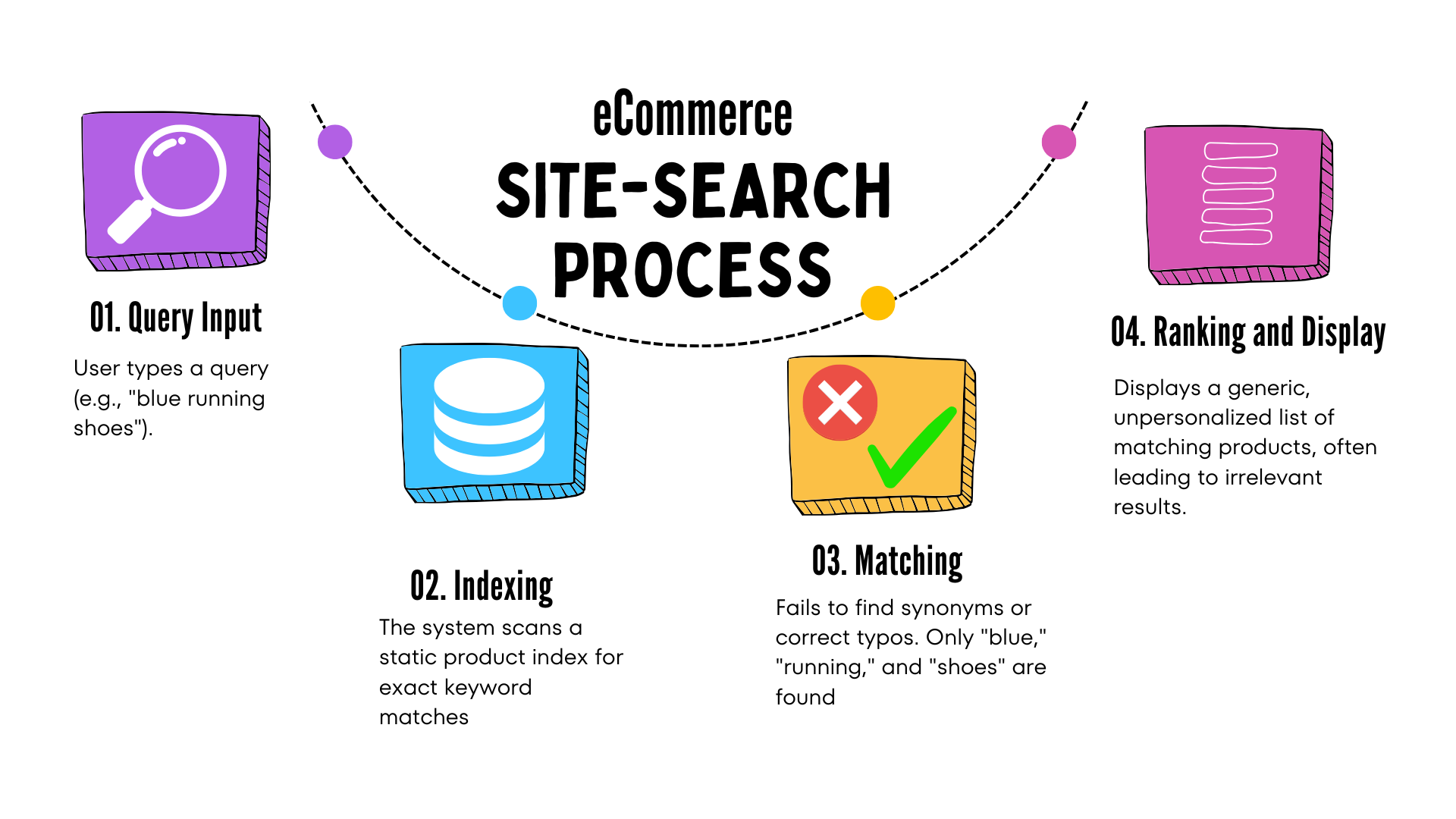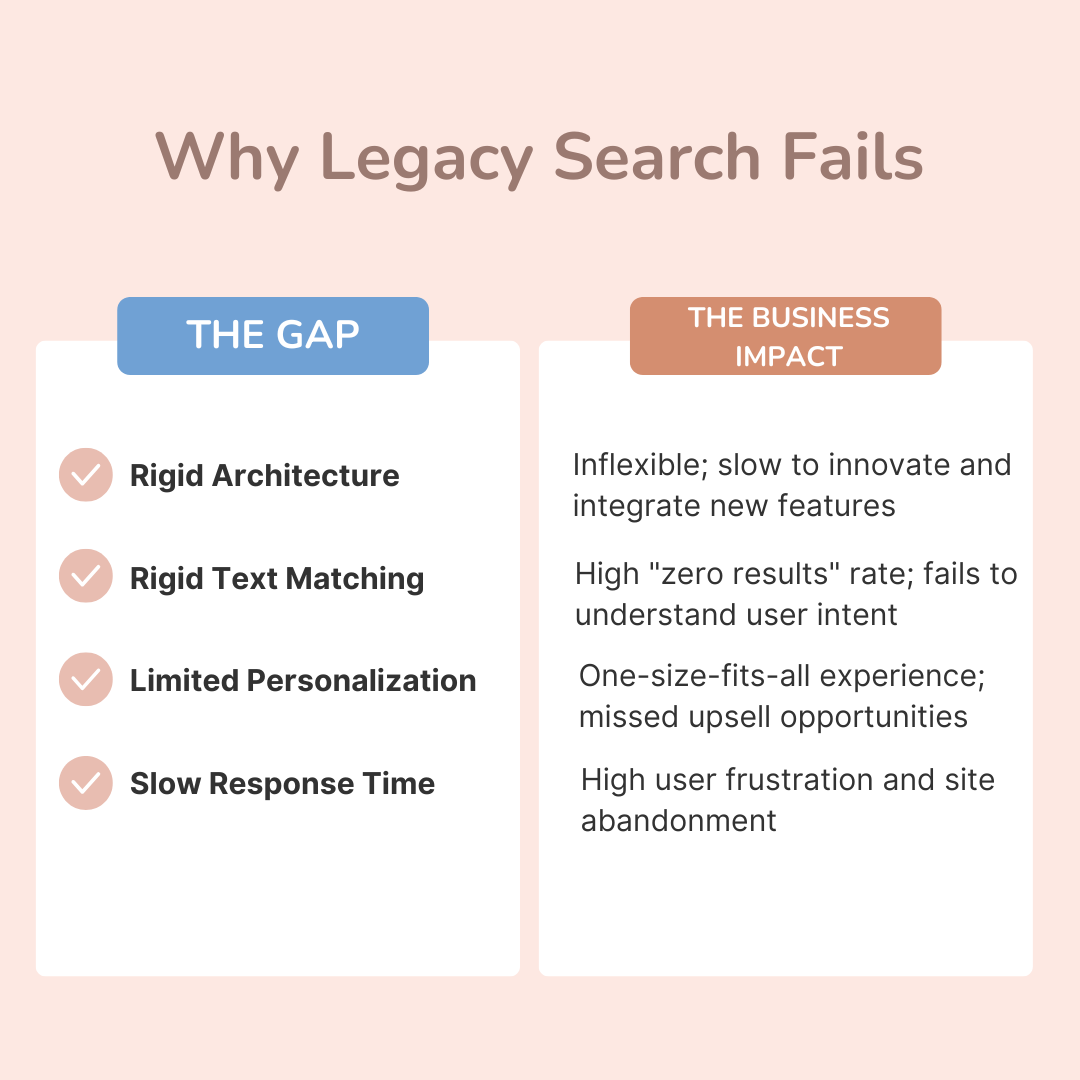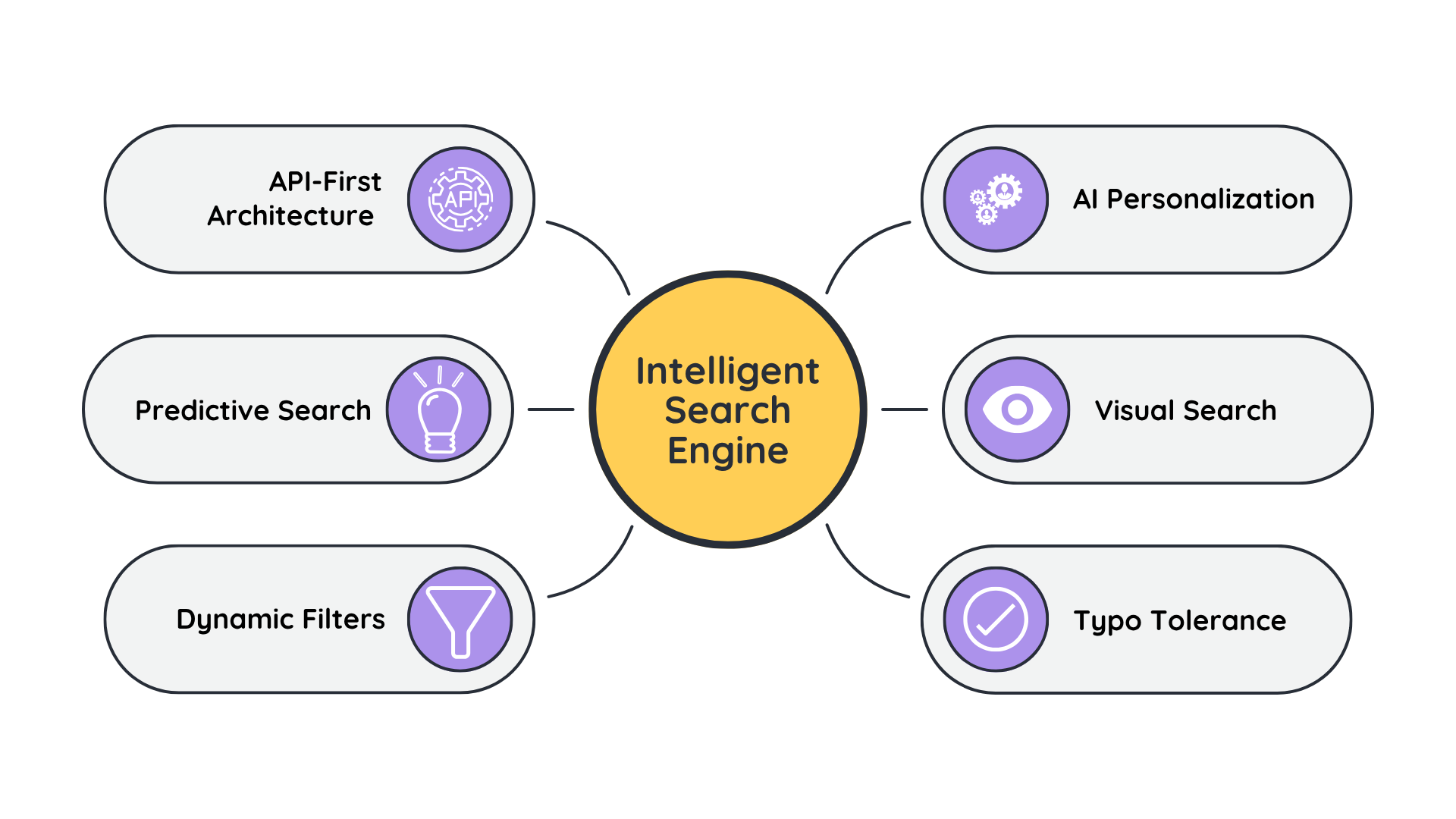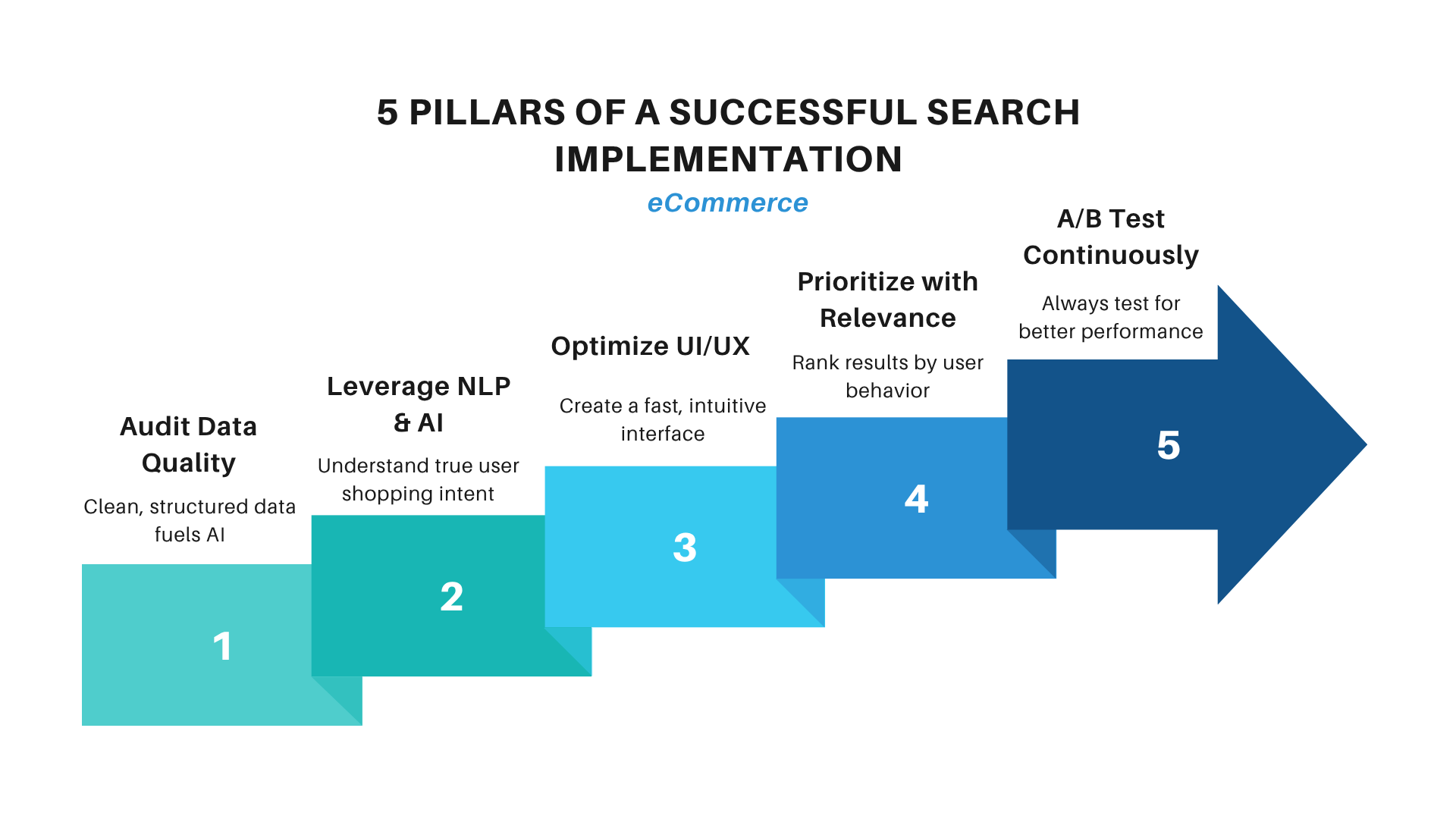Headless CMS Integration : The Ultimate Guide for Modern Ecommerce


For any online shopper, the experience is all too familiar: You land on a website with a specific product in mind, type its name in the search bar, and are met with a page of irrelevant results, or indeed worse, the dreaded “no results set up” communication. This moment of disunion is where deals are lost and customer loyalty breaks.
According to Forrester, Global eCommerce reached 4.4 trillion USD in 2023 and is projected to rise above with more than 6 trillion USD by 2028. But here’s the surprising part: only 24% of visitors actually use the search bar, and they’re the ones generating 44% of total site revenue.
Therefore, eCommerce site search should not be perceived as a simple utility but as a core component of your online store. It is a key navigator for high-intent buyers and an extremely powerful business intelligence engine that captures the unfiltered voice of the customer.
In this guide, we will explore what an eCommerce site search is, starting with the basics of what it is and how it works. We will also explore its strategic importance, identify the common gaps in legacy systems, and detail advanced features that provide a solution.
eCommerce site search refers to the on-site capability that enables a customer to input a text-based query into a search bar to look for specific products inside the retailer’s digital catalog. Ideally, it serves as an immediate bridge between the user’s expressed intent and all pertinent products ready for purchase.
Although this looks straightforward, how effective that bridge is will dictate whether a user’s journey leads to a satisfied transaction or a frustrated disengagement. With a properly performed product discovery, user experience is immediately enhanced because the most relevant traffic is routed to the site, and the purpose-driven visitors are satisfied.

To understand why user searches fail and get a bad experience on sites, it’s essential to first understand the fundamental mechanics behind how the traditional search system operates. The basic search process generally involves 4 key steps:
Many eCommerce businesses are still stuck with search tools that leave shoppers frustrated. The root of poor search performance often lies in legacy monolithic architectures. These catch-all platforms weren’t built to deliver the speed and adaptability consumers now demand. Key gaps include:
The outcome is stark. Findings by Google say that over 2 trillion USD globally is what retailers lose due to poor search experiences. Decision-makers must bridge these gaps to protect profits and attract loyal, high-value customers.

One of the key strategies is to migrate from the monolithic model of the eCommerce site search to microservices or API-first architecture. This enables the search functionality to be separated from the core eCommerce platform; hence, it can function as an autonomous, sharply focused service.
This offers the benefits of scalability and flexibility, which makes it easier to integrate modern solutions like Elasticsearch and Algolia, which are specifically designed for advanced query processing.
Modern search engines don’t just mirror the words users input, but they proactively suggest entire products, full categories, and even entire autocomplete phrases, creating a seamless flow that anticipates what a shopper might want next.
Research by Google suggests that autocomplete functionality can decrease typing effort by a quarter and increase sales by almost a quarter. The advanced algorithms use the past user behavior and current trending queries to surface the most pertinent choices first, reducing the number of clicks and the chance of frustration.
Nowadays, filters are not just static options like price, size, color, etc. Faceted search lets shoppers slice and dice choices by a spectrum of criteria, including context, stock, user ratings, and more. This ensures shoppers always see the most relevant options and never hit a dead end.
Artificial intelligence has become the core engine of product discovery on the web. Today’s systems analyze user actions the moment they happen, recalibrating product surfaces in real time. Full-featured platforms present personalized product clusters that reflect what the user has bought, what they’ve browsed, and even what they might want next, moving beyond the limits of static query responses.
Uploaded or taken images can now be used to search for products visually. This emerging technology is crucial for closing the gap between inspiration and purchase in instant gratification categories like fashion and home decor. This can stimulate shopper engagement and yield a higher probability for conversion.
Have you seen phrases like “Did You Mean?” while searching the eCommerce site or even Google search? That’s exactly what an online store needs! It automatically fixes typos, so shoppers can find what they’re looking for even if they spell it incorrectly. Search bar functionality must ensure that it autocompletes the user’s search queries with more relevant typos and autocomplete or suggest a “Did You Mean”.

The impact on business of advanced site search is quantifiable and compelling.
Start by analyzing user behavior like tracking zero-result searches, noting where customers drop off, and tallying recurring queries, as they tell which area needs immediate updates. Remember, AI is only as strong as its input – a detailed audit and cleanup of your product catalog is a non-negotiable foundation.
Implement intelligent autocomplete to guide users with product searches. A well-architected autocomplete feature can boost completion rates by up to 30%, while ease of typing can improve by 25%.
Start by making product search intuitive, like smart auto-suggestions, fast loading, and dynamic filters, which can go a long way in improving the experience. You can also take it further with voice search. Imagine a customer saying, “Hey Google, show me summer dresses” and landing directly on your site. Voice tech is growing fast – in fact, it accounted for $4.6 billion in transactions back in 2021, and it’s projected to grow to $164 billion by 2025.
Track user engagement like clicks, items added to carts, and purchases by utilizing artificial intelligence (AI). As a result, the most relevant options will rise to the surface for each user. Tailored rankings improve conversion rates and facilitate the user journey.
Consistently improve refinement through A/B testing and the search-based experience. Change the algorithm, layout, and filter position, then re-evaluate. This disciplined cycle guarantees that only the version driving the most engagement stays live, which ultimately translates to higher sales.
Finally, fine-tune usability by adding strong typo tolerance and a broad synonym list. These features help customers find products even when they mistype. Pair that with a “Did you mean?” prompt to further guide users, preventing frustrating “0 results found” or “No search for this product” pages.

Search bars in eCommerce businesses shouldn’t be neglected and underutilized, as it has now become a critical battleground for revenue and customer loyalty. Leaving its performance to outdated, rigid systems is a direct threat to your bottom line. A modern, AI-driven intelligent search strategy flips that risk into opportunity, turning a vulnerability into the strongest lever for increasing conversions. This move is not optional as it is the bedrock on which you will read user intent, drive sales, and secure a dominant position in the market.
Thinking about upgrading your eCommerce site’s search experience? At RBM Software, we help businesses build fast, intelligent, and scalable search tools that actually improve conversions and keep customers coming back.
Schedule a free consultation with RBM Software today to assess your current search capabilities and see how we can modernize your current setup, improve product discovery, and bring your platform up to speed.